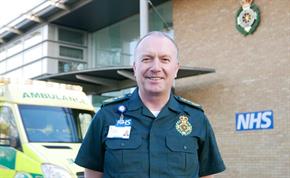
I would like to start by saying a huge thank you to our Paramedic colleague Heidi from Norfolk, who appeared on ITV’s This Morning this week to speak bravely about her ordeal after being assaulted by a patient. I highly commend her for going on national television to talk about something so personal, and that affects patient-facing staff on a day to day basis. The section was part of a campaign by radio presenter Nick Ferrari to make it a specific criminal offence to attack any member of NHS medical staff. I strongly condemn violence of any kind against any of our staff or volunteers and fully support a national campaign for legislative changes to protect all staff and volunteers.
Our winter pressures and capacity gap continues this week. Student abstractions will reach an all-time high of up to 7,000 hours in a single week. The next four week period will be a challenge, and means our dependence on private ambulance service support will continue, if we are to protect student attendance at university.
I would like to thank everyone’s involvement in last week’s adverse weather warnings of snow and flooding. Our emergency planning resilience and response (EPRR) teams did a brilliant job of supporting the evacuation of patients, care homes and other vulnerable medical patients. It was great to see everyone pool our efforts and commitment to support our patients and each other.
Sticking with the theme of pressure, I also want to thank all of those staff whom have recognised the necessity for our gold commanders, who have, in the interests of patient safety, had to take the difficult decision to suspend fixed meal break points during some surge black periods over the festive season. This is not an ideal situation and I apologise on behalf of the Trust to all those affected and want to thank all of you for your patience. Your contribution was much appreciated as this meant we could begin to respond to what was sometimes a significant stack of 999 patients waiting for a response.
Despite the continuing pressure on the NHS, service delivery continues to improve. Ambulance waits for life-threatening calls continue to reduce. We are now consistently putting out in excess of 100% of our budgeted ambulance capacity and up to 95% of our budgeted RRV capacity. This is a reflection of the hard work of everyone involved, so thank you all. And tail breaches, the official description of ambulance delays for our red calls, are now consistently below 1% of all red calls. Our shift in focus to targeting ambulances at those calls which are more likely to require conveyance is an important element to this improvement. This focus will serve us well as we continue to see the evaluation of the Ambulance Response Programme progress. Early indications suggest that the ambulance to RRV ratio will shift in favour of ambulances as we are likely to see a need for a reduction in multiple resources being sent to the same patient.
We have also seen a big improvement in the way we clinically treat patients. Over the last six months, our area clinical leads have been working hard to improve our ambulance clinical quality indicators (ACQI) performance. We have seen a significant trend of improvement in areas such as Stroke 60 despite the fact that in the early part of 2016, there were many pathway changes at some hospitals. This is most welcome and has been commented on by some of our members of Parliament.
The success of our emergency clinical advice and triage centre (ECAT) also continues. This development, as part of our new operating model, is a key factor in making sure we do not send a physical response to a call originating from 999 unless it is necessary to do so. When deemed so, we also want to ensure we send the most appropriate response. Last week, a trial to help care for patients who have suffered a fall in Norfolk launched; between Thursday and Sunday, the team saw six patients, four of which were conveyed to hospital and two were left at home. While four of the six patients were conveyed to hospital, the initial assessment meant that more appropriate resources were used to transport those patients, e.g. RRV/St Johns/health care referral team (HCRT) teams, which frees up our emergency ambulances. Together with other initiatives, like the mental health street triage we continue to develop pathways for patients other than conveyance to hospital by our ambulances.
I am pleased to say that the Essex and Herts Air Ambulance Trust launched their new late car from North Weald. The car will be working on Friday and Saturday evenings between 6pm and 2am and will have the same equipment, clinical team and medical capabilities as the usual helicopter and car teams have. It’s good to see that we can provide more enhanced critical care to patients than before.
The patient transport service (PTS) contract, which started in Cambridgeshire last September have had some challenges, however, with lots of hard work, the team have worked with stakeholders to ensure patient experience has improved.
And finally, I would like to mention a paramedic from Kempston who went to visit some of my former colleagues in Australia to experience the healthcare provided out there. Kim Taylor went out with the ambulance crews in New South Wales and experienced how the hospitals operate. She told me it was a great experience, thank you Kim and glad you had a good time.
Have a good week
Robert
Published 19th January, 2017